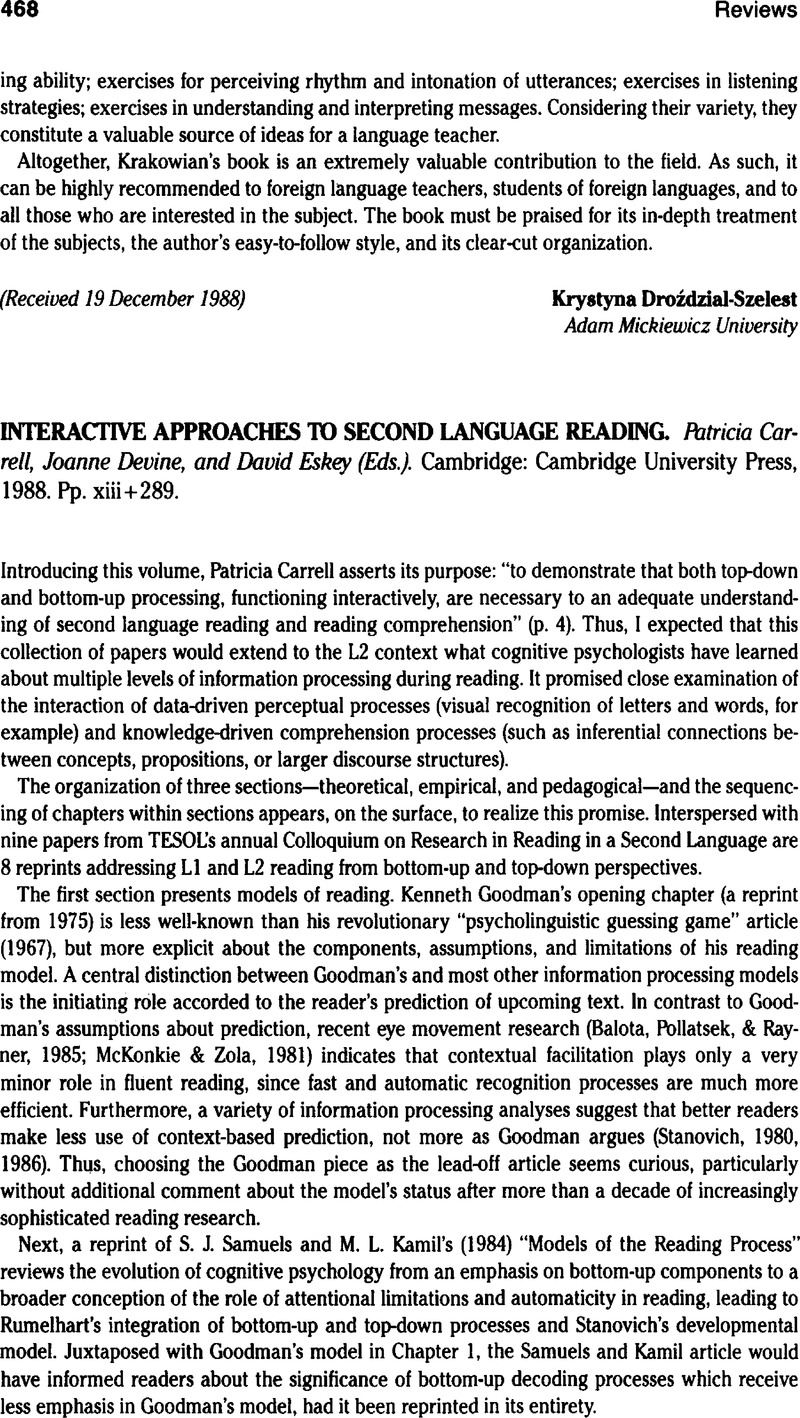No CrossRef data available.
Article contents
INTERACTIVE APPROACHES TO SECOND LANGUAGE READING. Patricia Carrell, Joanne Devine, and David Eskey (Eds.). Cambridge: Cambridge University Press, 1988. Pp. xiii+289.
Review products
INTERACTIVE APPROACHES TO SECOND LANGUAGE READING. Patricia Carrell, Joanne Devine, and David Eskey (Eds.). Cambridge: Cambridge University Press, 1988. Pp. xiii+289.
Published online by Cambridge University Press: 07 November 2008
Abstract
An abstract is not available for this content so a preview has been provided. Please use the Get access link above for information on how to access this content.

Information
- Type
- Reviews
- Information
- Copyright
- Copyright © Cambridge University Press 1989
References
REFERENCES
Balota, D. A., Pollatsek, A., & Rayner, K. (1985). The interaction of contextual constraints and parafoveal visual information in reading. Cognitive Psychology, 17, 364–390.CrossRefGoogle ScholarPubMed
Bransford, J. D., Stein, B., & Shelton, T. (1984). Learning from the perspective of the comprehender. In Alderson, J. C. & Urquhart, A. H. (Eds.), Reading in a foreign language (pp. 28–44). New York: Longman.Google Scholar
Brown, T., & Haynes, M. (1985). Literacy background and reading development in a second language. In Carr, T. (Ed.), The development of reading skills (pp. 19–34). San Francisco: Jossey-Bass.Google Scholar
Goodman, K. S. (1967). Reading: A psycholinguistic guessing game. Journal of the Reading Specialist, 6, 126–135.CrossRefGoogle Scholar
Kintsch, W. (1988). The role of knowledge in discourse comprehension: A construction-integration model. Psychological Review, 95, 163–182.CrossRefGoogle ScholarPubMed
McKonkie, G. W., & Zola, D. (1981). Language constraints and the functional stimulus in reading. In Lesgold, A. M. & Perfetti, C. A. (Eds.), Interactive processes in reading (pp. 155–175). Hillsdale, NJ: Erlbaum.Google Scholar
Meara, P. (1984). Word recognition in foreign languages. In Pugh, A. K. & Ulijn, J. M. (Eds.), Reading for professional purposes (pp. 97–106). London: Heinemann.Google Scholar
Meara, P., Coltheart, M., & Masterson, J. (1985). Hidden reading problems in ESL learners. TESL Canada Journal, 3, 29–36.CrossRefGoogle Scholar
Silberstein, S. (1987). Let's take another look at reading: Twenty-five years of reading instruction. English Teaching Forum, 25(4), 28–35.Google Scholar
Singer, M. H. (1982). Competent reader, disabled reader: Research and applications. Hillsdale, NJ: Erlbaum.Google Scholar
Smith, F. (1982). Understanding reading (3rd ed.). New York: Holt, Rinehart & Winston.Google Scholar
Stanovich, K. E. (1980). Toward an interactive-compensatory model of individual differences in the development of reading fluency. Reading Research Quarterly, 16, 32–71.CrossRefGoogle Scholar
Stanovich, K. E. (1986). Matthew effects in reading: Some consequences of individual differences in the acquisition of literacy. Reading Research Quarterly, 21, 360–407.CrossRefGoogle Scholar

